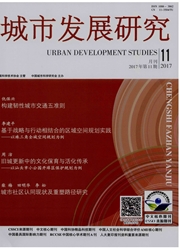

 中文摘要:
中文摘要:
在对人居环境关注的宽度与深度发展之下,居住区规划正在向注重社会生活质量的社区规划转变。在中国,社区存在概念不清,边界不明的问题,亟须从生活空间视角,对社区的概念和空间进行重构。在梳理了国内外社区建设模式、生活空间、生活圈等相关研究的基础上,以北京清河地区为案例,采用GPS数据和活动日志数据,基于个体行为方法,依照功能和可达性两个维度提出日常生活圈的基本概念;并运用Alpha-shape方法,选择18个社区进行社区生活圈的实证测度。研究结果表明,较之以往居住小区,社区生活圈更能反映居民真实生活空间。研究还证明,Alpha-shape方法较之传统方法在测度生活圈方面更具优势。
 英文摘要:
英文摘要:
With the widely and deeply focus on the living environment, more attention is nowadays paid to the community planning which is characterized by life quality than living area planning. Yet in China, the concept of community is ambiguous, and the boundary remains hard to define. Therefore, emergent work need to be conducted to reconstruct both the concept and the space of community, from the perspective of living space. This article, after combing relevant researches such as community construction pattern of China, life space and live circle, taking Qinghe Area as case and employing GPS data and activity diary data, puts forward the basic concept of Daily Life Circle (DLC) based on space-time behavior methods. Furthermore, this article takes 18 case community to conducts measurement of Neighborhood Life Circle(NLC) with Alpha-shape method. The results show that, compared to the residential quarter named Xiaoqu, the NLC can reflect the true life space more efficiently. Additionally, Alpha-shape method has an advantage over other methods in measuring DLC. The discussion of NLC provides a new way to understand the suburban communities, and offers reference to the living space planning in aspects of theory and methodology innovation.
 同期刊论文项目
同期刊论文项目
 同项目期刊论文
同项目期刊论文
 期刊信息
期刊信息
